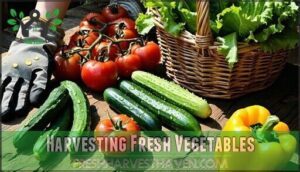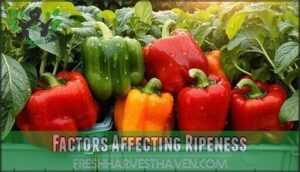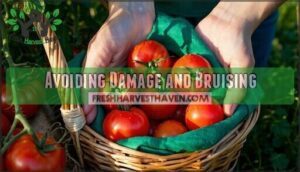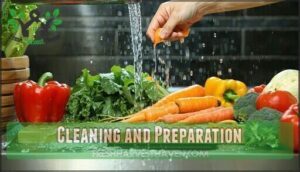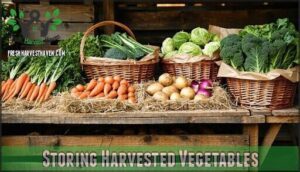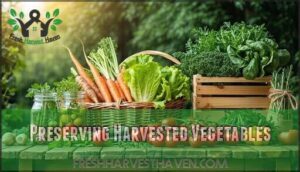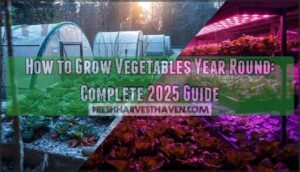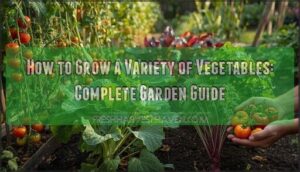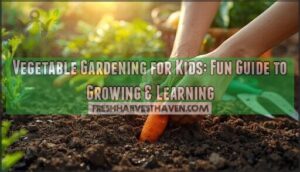This site is supported by our readers. We may earn a commission, at no cost to you, if you purchase through links.
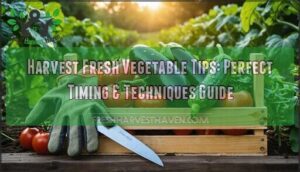
Pick veggies early in the morning, when they’re at their peak flavor—think of it as catching them before they’ve had their morning coffee.
Use a sharp knife or pruners instead of yanking, so you don’t bruise or damage those beauties.
Look for signs of ripeness: firm cucumbers, glossy eggplants, and that satisfying “snap” from green beans.
Handle your haul gently and stash cucumbers in the fridge, while eggplants chill at room temp.
Stick around for more secrets—there’s plenty more in the garden shed to share.
Table Of Contents
- Key Takeaways
- Harvesting Fresh Vegetables
- When to Harvest Vegetables
- Handling Harvested Vegetables
- Storing Harvested Vegetables
- Preserving Harvested Vegetables
- Frequently Asked Questions (FAQs)
- Are there rules to harvesting vegetables?
- How should I harvest vegetables?
- How do you keep vegetables fresh after harvest?
- How do you pick a vegetable if it’s not ready to pick?
- How do I preserve my harvest?
- How do you know if a vegetable is ready for harvest?
- How to properly harvest vegetables?
- How can you keep fresh vegetables from turning brown?
- How to keep cut up veggies fresh in the fridge?
- How do I know when my veggies are ready to pick?
- Conclusion
Key Takeaways
- You’ll pick veggies at their best by harvesting them in the cool morning, after the dew dries, to get the best flavor and crispness.
- To keep veggies fresh, you’ll store them in cold, moist conditions, handling them with care, and monitoring temperature, moisture, and ventilation to retain ideal taste and quality.
- You can preserve your harvest through various methods like pickling, canning, freezing, or drying, which will help you enjoy your veggies year-round and retain their flavor and nutrition.
- You’ll know veggies are ready to pick when they reach recommended sizes, colors, and firmness, and exhibit specific characteristics, like tomatoes being fully colored and firm to touch, so you can harvest them at the right time.
Harvesting Fresh Vegetables
Harvesting fresh vegetables at the right time guarantees you get the best flavor and longest storage life.
Harvesting fresh vegetables at their peak rewards you with unmatched flavor and lasting freshness for every meal.
Understanding when and how to pick each crop helps you protect your harvest and keep your vegetables crisp and tasty.
Optimal Harvest Time
Catching vegetables at their best is like picking the winning apple from the tree. For ideal flavor and freshness, aim to harvest in the cool morning after dew dries.
Remember:
- Morning Sweetness boosts taste.
- Dew Impact assures crispness.
- Heat Avoidance prevents wilting.
- Dry Harvesting keeps diseases away.
Consider using a harvest timing guide to maximize your yield. If you miss mornings, evening is your next best bet to achieve optimal results.
Techniques for Harvesting
You’ll master harvesting techniques by using cutting techniques, gentle handling, and considering harvesting frequency to minimize damage, guaranteeing the best results for your vegetables, with tips on harvesting timing and methods guided by vegetable cues.
To guarantee efficient harvesting, consider investing in specialized harvesting equipment.
| Harvesting Methods | Harvesting Tips | Harvesting Timing |
|---|---|---|
| Cutting | Handle gently | Morning |
| Picking | Avoid damage | Evening |
| Twisting | Check frequency | Weekly |
| Pulling | Use proper tools | Daily |
| Snipping | Monitor cues | Seasonally |
Tools for Harvesting
You’ll need sharp, ergonomic harvesting tools with importance on sharpness for efficient vegetable picking.
Specialized tools, like pruning tools, and cleaning tools are essential for harvesting vegetables, ensuring a clean cut and minimal damage, making tool maintenance vital for successful vegetable tips and picking vegetables.
Consider investing in ergonomic tool options to reduce strain and improve overall harvesting efficiency with the right tools.
When to Harvest Vegetables
You’re about to learn when to harvest your vegetables for the best flavor and texture.
By understanding the ideal harvest time, you’ll be able to pick your vegetables at their peak freshness and enjoy them all season long.
Signs of Ripeness
You check your vegetables for ripeness using visual indicators like color, texture assessment, and aroma detection, ensuring you pick ripe vegetables at the right maturity stages, with characteristics like vibrant color and slight yield to pressure, indicating ideal vegetable ripeness.
For example, when evaluating avocados, it’s important to check the fruit’s stem end for ripeness.
Checking for Maturity
You’ll know vegetables are mature by checking visual ripeness, touch indicators, and aroma clues.
Size matters, so refer to the seed packet for guidance on vegetable maturity, ensuring you pick ripe vegetables at the right time, considering texture and color indicators for ideal vegetable ripeness.
Factors Affecting Ripeness
You consider several factors affecting ripeness, including:
- Environmental Influence
- Genetic Predisposition
- Nutrient Availability
- Pest Damage, to determine ideal flavor and texture indicators, and color indicators for vegetable maturity and ripeness.
Harvesting too early can prevent proper pigment synthesis.
Handling Harvested Vegetables
You’ll want to handle your harvested vegetables with care to keep them fresh and prevent damage.
By using gentle handling techniques, you can minimize bruising and keep your vegetables in great condition for storage, preparation, or immediate use to ensure they remain fresh.
Gentle Handling Techniques
You’ll want to handle vegetables gently to minimize bruising.
Use gentle handling techniques to prevent damage.
| Tool Selection | Washing Produce | Transport Methods |
|---|---|---|
| Sharp knives | Cool water | Ventilated containers |
| Clean cuts | Gentle spraying | Cushioned boxes |
| Pruning shears |
Avoiding Damage and Bruising
When handling vegetables, you’ll prevent bruising by using gentle handling techniques.
Here are tips:
- Handle with care
- Avoid squeezing
- Use proper tools, ensuring bruise prevention and gentle handling for harvesting best practices.
Using padded containers can also help, as they cushion produce.
Cleaning and Preparation
When cleaning fresh vegetables, gently wash produce to prevent bruising.
Master trimming techniques and peeling methods to preserve quality and freshness, making preparing salads and cooking prep easier, while maintaining vegetable handling and bruising prevention standards for superior vegetable quality.
Storing Harvested Vegetables
You’ve harvested your vegetables, now it’s time to store them properly to maintain their freshness and quality.
By following the right storage techniques, you can keep your vegetables fresh for a longer period, and enjoy them in various dishes throughout the year.
Short-Term Storage Methods
After carefully handling your fresh vegetables, proper refrigerator storage keeps them at their peak for days.
Cold temperatures slow down spoilage while maintaining crispness and flavor.
- Temperature control: Store most vegetables at 32-40°F in your refrigerator’s crisper drawer
- Humidity management: Keep leafy greens in high-humidity zones, root vegetables in moderate humidity
- Ethylene separation: Store ethylene-producing fruits away from sensitive vegetables to prevent premature ripening
Use perforated bags or breathable containers for ideal air circulation.
Don’t wash produce until you’re ready to use it.
Long-Term Storage Techniques
Root cellaring transforms your harvest into year-round nourishment through controlled atmosphere techniques.
Cold storage at 33-34°F with 90-95% humidity creates ideal conditions for vegetable preservation. Curing vegetables like onions and potatoes before storage extends their life substantially.
Modified atmosphere storage using proper ventilation prevents spoilage while maintaining quality for months ahead, which is crucial for successful cold storage and overall year-round nourishment.
Factors Affecting Shelf-Life
Why do your vegetables turn into science experiments in the fridge faster than you’d like?
Several key factors determine how long your harvest stays fresh:
- Storage Temperature: Keep vegetables at their ideal temperature range – most prefer 32-40°F, while potatoes and winter squash need 50-60°F
- Humidity Levels: Match moisture needs – leafy greens require 95% humidity, onions need just 65-70%
- Air Circulation: Proper ventilation prevents spoilage by reducing moisture buildup and ethylene gas concentration around produce
Remember, vegetable storage success depends on controlling these storage conditions from day one.
To maximize freshness, consider morning harvest benefits, when vegetables are better hydrated.
Preserving Harvested Vegetables
Once you’ve mastered harvesting your vegetables at peak freshness, proper preservation techniques will help you enjoy your garden’s bounty year-round without waste.
These methods lock in nutrients and flavor while extending your harvest’s lifespan from days to months.
Freezing and Refrigeration
Two powerful methods lock in your harvest’s peak freshness. Refrigeration methods preserve vegetables for days or weeks, while freezing vegetables extends storage duration for months.
Blanching techniques prepare produce for freezing by stopping enzyme activity.
| Storage Method | Best Vegetables |
|---|---|
| Fresh Refrigeration | Leafy greens, carrots, broccoli |
| Freezing (blanched) | Corn, beans, peas, spinach |
| Freezing (unblanched) | Peppers, onions, herbs |
Most vegetables need blanching before freezing to maintain color and nutrition. Thawing produce works best when moved from freezer to refrigerator overnight, preserving texture and preventing bacterial growth.
Canning and Pickling Methods
Long-term preservation through canning and pickling transforms your fresh harvest into pantry staples.
These food preservation methods require attention to canning safety and proper jar sterilization to prevent spoilage.
- Water bath canning – Perfect for high-acid vegetables like tomatoes and pickled cucumbers using tested recipes
- Pressure canning – Essential for low-acid vegetables requiring higher temperatures for safe vegetable storage
- Pickling brines – Create flavorful preserved vegetables using vinegar solutions with various recipe variations
Dehydration and Other Techniques
Dehydration transforms fresh vegetables into shelf-stable treasures. You can dehydrate slices using electric dehydrators or your oven’s lowest setting.
Fermentation benefits include probiotics and extended storage—try sauerkraut or kimchi. Root cellaring keeps potatoes and carrots fresh for months.
Vacuum sealing removes air, preventing spoilage. Oil preservation works beautifully for sun-dried tomatoes and peppers.
For best results, consider blanching before freezing via blanching before freezing, to achieve optimal extended storage.
Frequently Asked Questions (FAQs)
Are there rules to harvesting vegetables?
Ever wonder if there’s a secret code to harvesting?
Timing’s everything—pick in the cool morning, handle produce with care, use sharp, clean tools, and store smart.
That’s how you keep veggies crisp, flavorful, and long-lasting.
How should I harvest vegetables?
Pick vegetables early in the morning, after the dew dries, for the best flavor and crispness.
Use sharp, clean tools; handle produce gently to avoid bruising.
Check size, color, and feel to be sure they’re ripe.
How do you keep vegetables fresh after harvest?
You keep vegetables fresh after harvest by storing them in cold, moist conditions, handling with care, and monitoring temperature, moisture, and ventilation to retain ideal taste and quality.
How do you pick a vegetable if it’s not ready to pick?
You wait, checking size, color, and firmness, and refer to seed packet information to determine if a vegetable is ready to pick, avoiding premature harvesting.
How do I preserve my harvest?
You can preserve your harvest through pickling, canning, freezing, or drying to enjoy your vegetables year-round and retain their flavor and nutrition.
How do you know if a vegetable is ready for harvest?
You check vegetables for readiness by looking at size, color, and firmness, and referring to seed packet information for specific maturity signs.
How to properly harvest vegetables?
You’ll harvest vegetables properly by using sharp tools, handling gently, and picking at prime times, like early morning, to guarantee freshness and quality.
How can you keep fresh vegetables from turning brown?
You can keep fresh vegetables from turning brown by storing them in cold, moist conditions and handling them gently to prevent bruising and damage.
How to keep cut up veggies fresh in the fridge?
You store cut veggies in airtight containers, maintaining humidity and cool fridge temps to retain freshness and crunch for several days, making meal prep a breeze.
How do I know when my veggies are ready to pick?
You’ll know veggies are ready to pick when they reach recommended sizes, colors, and firmness, and exhibit specific characteristics, like tomatoes being fully colored and firm to touch.
Conclusion
Knowing that 40% of harvested veggies go to waste, you’re taking a step in the right direction by learning about harvest fresh vegetable tips.
You’ll now pick veggies at the right time, handle them gently, and store them properly, making the most of your harvest fresh vegetable tips and enjoying fresh produce all season long.
- https://als-gardencenter.com/blogs/tips-and-inspiration/mastering-the-art-of-harvesting-homegrown-vegetables
- https://hgic.clemson.edu/factsheet/harvesting-vegetables/
- https://www.bladeforums.com/threads/pruning-shears-vs-knife-for-smallish-vegetatuion.1335653/
- https://www.eatingwell.com/article/7951742/how-to-tell-if-eggplant-is-bad/
- https://extension.umn.edu/planting-and-growing-guides/harvesting-and-storing-home-garden-vegetables

